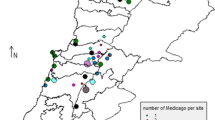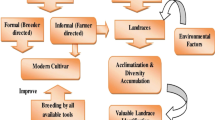Abstract
Climate change is causing a huge loss in biodiversity throughout the globe and the rate has accelerated in recent years. Plant diversity of temperate regions has continuously suffered due to this. The importance of conservation of wild relatives/species of staple crop such as Elymus, Leymus, Thinopyrum, Lolium either in situ or ex situ is essential to sustain these resources for future use due to their ability to withstand in a stressful environment. Thus plant researchers are always in a quest to explore novel species to enhance the genetic diversity of wild crop relatives to improve the resilience of staple crops to a wide range of stress conditions. Keeping these viewpoints in mind, in 2016–2018, we have explored the Lahaul valley, a cold arid region of District Lahaul and Spiti, Himachal Pradesh. A total of 230 accessions of four different species belonging to genus Elymus viz-E. semicostatus (Nees ex steud.) Meld., E. repens Gould, E. dahuricus Turrcz Ex Griseb. and E. longiaristatus (Boiss.) Tzvelev subsp. Canaliculatus (Nevski) Tzvelev belonging to the family Poaceae, tribe Triticeae were taken into consideration. Wide-range of variability was observed at an inter-and intraspecific level among these species. The variations in morphological characters at different ecological amplitudes were recorded. The presence of variation in abiotic stress tolerance traits such as spike pigmentation, low seed shattering, dense pubescence, waxiness was observed. Forty traits were recorded during field evaluation to ease wheat breeders and researchers to identify germplasm during the collection at an in situ level. The population of these four species had a variation for qualitative and quantitative traits at different ecological regimes at their native habitat suggesting their adaptability to a particular niche. Pre-breeding on these germplasm resources could be initiated for introgression novel alleles in wheat to mitigate environmental constraints posed by changing climate.




Similar content being viewed by others
References
Aswal BS, Mehrotra BN (1994) Flora of lahaul-spiti. (A cold desert in Northwest himalayas). Bishen Singh Mahendra Pal Singh, Dehradun, India
Bachereau F, Marigo G, Asta J (1998) Effect of solar radiation (UV and visible) at high altitude on CAM-cycling and phenolic compound biosynthesis in Sedum album. Physiol Plant 104:203–210
Bains NS, Singh S, Dhillon BS (2012) Enhanced utilization of plant genetic resources in crop improvement programmes. Indian J Plant Genet Retour 25:52–62
Baneji G, Basu S (2010) Adapting to climate change in Himalayan cold deserts. Int J Clim Change Strateg Mang 2:426–448
Bansal M, Kaur S, Dhaliwal HS, Bains NS, Bariana HS, Chhuneja P, Bansal UK (2017) Mapping of derived leaf rust and stripe rust resistance loci in wheat. Plant Pathol 66(1):38–44
Bhardwaj SC, Gangwar OP, Singh SB, Saharan MS, Sharma S (2012) Rust situation and pathotypes of Puccinia species in Leh Ladakh in relation to recurrence of wheat rusts in India. Indian Phytopath 65:230–232
Bhutiyani MR, Kale VS, Pawar NJ (2007) Long-term trends in maximum, minimum and mean annual air temperatures across the Northwestern Himalaya during the twentieth century. Clim Change 85:159–177
Bor NL (1970) Gramineae. In: Flora I, Rechinger KH (ed) Vol 70, Akademische Druk-Und Verlasantalt Wiena, Graz, Austria
Chaturvedi GS, Aggarwal PK, Singh AK, Joshi MJ, Sinha SK (1981) Effect of irrigation on tillering in wheat, triticale and barley in a water-limited environment. Irrig Sci 2:225–235
Colmer TD, Flowers TJ, Rana M (2006) Use of wild relatives to improve salt tolerance. J Exp Bot 57:1059–1078
Dante FP, Malachy T, Campbell JJ, Folsom XC, Greg R, Kumar P, Stephen B, Harkamal W (2013) Introgression of Novel traits from a wild wheat relative improves drought adaptation in wheat. Plant Physiol 161:1806–1819
Eckert CG, Samis KE, Lougheed SC (2008) Genetic variation across species’ geographical ranges: the central–marginal hypothesis and beyond. Mol Ecol 17:1170–1188
Gorham J, McDonnell E, Wyn Jones RG (1984) Salt tolerance in the Triticeae: Leymus sabulosus. J Exp Bot 35:1200–1209
Gross BL, Olsen KM (2010) Genetic perspectives on crop domestication. Trends Plant Sci 15:529–537
Hajjar R, Hodgkin T (2008) The use of wild relatives in crop improvement: a survey of developments over the last 20 years. Euphytica 156(1–2):1–13
Haussmann BIG, Parzies HK, Presterl Y, Susic Z, Miedaner T (2004) Plant genetic resources in crop improvement. Plant Genet Resour 2:3–21
Holubec V (2005) Triticeae biodiversity and conservation, a ‘“genebanker’s”’ view. Czech J Genet Plant Breed 41:118–121
Jarvis A, Upadhyaya H, Gowda C, Agrawal P, Fujisaka S, Anderson B (2008) Climate change and its effect on conservation and use of plant genetic resources for food and agriculture and associated biodiversity for food security. Monograph. Food and Agriculture Organization of the United Nations, UK
Kaur S, Jindal S, Kaur M, Chhuneja P (2018) Utilization of wild species for wheat improvement using genomic approaches biotechnologies of crop improvement. In: Gosal SS, Wani SH (eds) Biotechnologies of crop improvement, Vol 3, Springer International Publishing AG, pp 105–150
Kellogg EA, Peas C, Rudall PJ, Ladd P, Malcomber ST, Whipple CJ, Doust AN (2013) Early inflorescence development in the grasses (Poaceae). Front Plant Sci 4:250–256
King J, Grewal S, Yang C, Hubbart S, Scholefield D, Ashling S, Edwards KJ, Allen AM, Burridge A, Bloor C, Davassi A, Silva GJ, Chalmers K, King IP (2015) A step change in the transfer of interspecific variation into wheat from Amblyopyrum muticum. Plant Biotechnol J 15:217–226
Lala S, Nigel AA (2018) Towards the conservation of crop wild relative diversity in North Africa: checklist, prioritisation and inventory Maxted. Genet Resour Crop Evol 65:113–124
Lalu DJK (2019) Drivers of climate over the Western Himalayan region of India: a review. Earth-Sci Rev 198:102935
Lei C, Yongkang R, Timothy DM, Wenze Y, Qing G, Yuqi N, Sun Y, Li H (2018) Development of perennial wheat through hybridization between wheat and wheat grasses: a review. Engineering 4:507–513
Lopes MS, El-Basyoni I, Baenziger PS, Singh S, Royo C, Ozbek K, Aktas H, Ozer E, Ozdemir F, Manickavelu A, Ban T, Vikram P (2015) Exploiting genetic diversity from landraces in wheat breeding for adaptation to climate change. J Exp Bot 66:3477–3486
Miao J, Zhang X, Chen S, Ma X, Chen Z, Zhong J, Bai S (2011) Gliadin analysis of Elymus nutans Griseb. from the Qinghai-Tibetan Plateau and Xinjiang. China Grassl Sci 57:127–134
Murti SK (2001) Flora of Cold Deserts of Western Himalaya (Monocotyledon) Vol. 1(Monocotyledons). Dehradun: Botanical Survey of India
Nevo E, Chen GX (2010) Drought and salt tolerances in wild relatives for wheat and barley improvement. Plant Cell Environ 33:670–685
Placido DF, Campbell MT, Folsom JJ, Cui XP, Kruger GR, Baenziger PS, Walia H (2013) Introgression of novel traits from a wild wheat relative improves drought adaptation in wheat. Plant Physiol 161:1806–1819
Pusalkar PK, Singh DK (2012) Flora of Gangotri National Park, Western Himalaya, India. Kolkata: Botanical Survey of India
Redden R, Yadav SS, Maxted N, Dulloo ME, Guarino L, Smith P (2015) Crop wild relatives and climate change. Wiley, Hoboken
Sexton JP, Hangartner SB, Hoffmann AA (2014) Genetic isolation by environment or distance: which pattern of gene flow is most common? Evolution 68:1–15
Shrestha UB, Gautam S, Bawa KS (2012) Widespread climate change in the Himalayas and associated changes in local ecosystems. PLoS ONE 7:e36741
Singh KN, Lal B, Singh RD, Todaria NP, Ahuja PS (2007) Species richness, distribution pattern and conservation status of higher plants in the Spiti cold desert of trans-Himalaya, India. Int J Biol Sci Manag 3:223–233
Sohail Q, Inoue T, Tanaka H, Eltayeb AE, Matsuoka Y, Tsujimoto H (2011) Applicability of Aegilops tauschii drought tolerance traits to breeding of hexaploid wheat. Breed Sci 61:347–357
Toll JA, Moss H (1995) Reporting on germplasm collection missions. In: Guarino L, Ramanatha Rao V, Reid R (eds) Collecting plant genetic diversity: technical guidelines. CABI International, Wallingford, pp 597–613
Vaish SS, Ahmed SB, Prakash K (2011a) First documentation on status of barley diseases from the high altitude cold arid Trans-Himalayan Ladakh region of India. Crop Prot 30:1129–1137
Yan XB, Guo YX, Liu FY, Zhao C, Liu QL, Lu BR (2010) Population structure affected by excess gene flow in self-pollinating Elymus nutans and E. burchan-buddae (Triticeae: Poaceae). Popul Ecol 52:233–241
Yumurtaci A (2015) Utilization of wild relatives of wheat, barley, maize and oat in developing abiotic and biotic stress tolerant new varieties. Emir J Food Agric 27:1–23
Zeng J, Cao W, Hucl P, Yang Y, Xue A, Chi D, Fedak G (2013) Molecular cytogenetic analysis of wheat—Elymus repens introgression lines with resistance to Fusarium head blight. Genome 56:75–82
Zhang H, Mittal N, Leamy LJ, Barazani O, Song BH (2017) Back into the wild—apply untapped genetic diversity of wild relatives for crop improvement. Evol Appl 10:5–24
Zhang JB, Bai SQ, Zhang XQ, Ma X, Yan JJ, Zhang CB, You MH (2009) Study on ear characters of Elymus nutans Griseb. in the north western plateau of Sichuan province. J Sichuan Univ (Nat Sci Ed) 46:1505–1509
Funding
There is no funding source for the research work.
Author information
Authors and Affiliations
Corresponding author
Ethics declarations
Conflict of interest
Authors declare no conflict of interest.
Additional information
Communicated by M. Molnár-Láng.
Rights and permissions
About this article
Cite this article
Kumar, A., Sharma, A., Sharma, R. et al. Exploration of wheat wild relative diversity from Lahaul valley: a cold arid desert of Indian Himalayas. CEREAL RESEARCH COMMUNICATIONS 50, 305–320 (2022). https://doi.org/10.1007/s42976-021-00166-w
Received:
Accepted:
Published:
Issue Date:
DOI: https://doi.org/10.1007/s42976-021-00166-w




